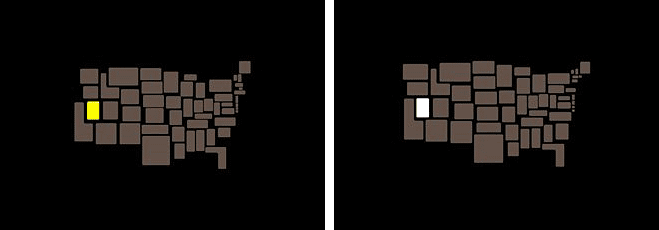visual design
It’s a bluff, John, call it off

The principle of Feng shui - to arrange rooms and buildings in ways that are pleasing and health-giving - has popular appeal. Unfortunately, Feng shui’s scientific credentials are lacking, being based as it is on the ancient Chinese concept of Ch’i or life-force. The good news is that psychologically informed, evidence-based design is on the increase. Consider this new study by Sibel Dazhir and Marilyn Read, which has compared the effects of curvilinear (rounded) and rectilinear (straight-edged) furniture on people’s emotions. (…)
The two room versions full of curvilinear furniture provoked significantly higher pleasure and approach ratings from the students. (…) It’s worth considering whether rectilinear-themed rooms may have their own benefits for purposes other than relaxing and socializing.
interior { Chad McPhail }
‘What the public wants is the image of passion, not passion itself.’ –Roland Barthes
The art of the before-and-after photograph
In the first decade of the 20th century, Madame C.J. Walker — an African-American entrepreneur who made a fortune selling hair care products — demonstrated the dramatic results her wares could deliver via advertisements that used before-and-after photos of Madame Walker herself.
In Madame Walker’s “before” photo, her hair is short and kinky. In two “after” shots, it’s long, silky, and luxurious. In this regard, the sequence helped establish the parameters of the before-and-after format in the realm of advertising. The technique wasn’t just for showing incremental change. It was for showing fantastic, life-altering transformations, metamorphoses so amazing they’d be downright unbelievable were they not being depicted in a medium as ostensibly incapable of deceit as photography.
You checked with the bank, no? They never laid eyes on her, no? You still trustin’? Hot creepers!

Dazzle camouflage, also known as Razzle Dazzle or Dazzle painting, was a camouflage paint scheme used on ships, extensively during World War I and to a lesser extent in World War II. Credited to artist Norman Wilkinson, it consisted of a complex pattern of geometric shapes in contrasting colours, interrupting and intersecting each other.
{ Wikipedia | Continue reading | more photos }
Face-detection software is everywhere. Defeat it with some artfully-applied, avant-garde face makeup called CV Dazzle.
CV Dazzle is named after the ingenious warship-camouflage designs deployed during World War I. Rather than actually hiding military vessels, the bold, jagged paint jobs made it difficult for naval rangefinders to discern details about the ship’s size, heading, armament, and so forth. Or at least, that was the idea — unlike Harvey’s digital version, the original Dazzle’s effectiveness was never proven. Of course, CV Dazzle benefits from the fact that face-detection software is much stupider than WWI seamen: you only have to apply a few strokes of face-paint to confuse it, rather than coat your whole kisser.
‘It is a scientific fact that if you stay in California, you lose one point off your IQ every year.’ –Truman Capote

from Australia { Shaun Gladwell, Interceptor Surf Sequence, 2009 }
‘History is a set of lies that people have agreed upon.’ –Napoleon Bonaparte

We modify our own opinions in line with what other people think, especially our friends and peers.
A problem for psychologists investigating the effect of peer influence is that it can be tricky to tell whether people are simply acquiescing in public, for show, or if their attitudes really have changed.
A new study by a team of psychologists at Harvard University has used an innovative mix of behavioural and brain-scan methods to show that peer influence really can change how people value something, in this case the attractiveness of a face.
photos { William Klein, Man Foreground, Woman Behind, 1955 | Right: Man Ray, Self-Portrait with Meret Oppenheim, 1933 }
‘Why must we proclaim so loudly and with such intensity what we are, what we want, and what we do not want?’ –Nietzsche

When adding up the benefits from three centuries of species discoveries, I’m tempted to start, and also stop, with Sir Hans Sloane.
A London physician and naturalist in the 18th century, he collected everything from insects to elephant tusks. And like a lot of naturalists, he was ridiculed for it, notably by his friend Horace Walpole, who scoffed at Sloane’s fondness for “sharks with one ear, and spiders as big as geese!” Sloane’s collections would in time give rise to the British Museum, the British Library, and the Natural History Museum, London.
Not a bad legacy for one lifetime. But it pales beside the result of a collecting trip to Jamaica, on which Sloane also invented milk chocolate.
We still scoff at naturalists today. We also tend to forget how much we benefit from their work. (…) Large swaths of what we now regard as basic medical knowledge came originally from naturalists.
photos { Simen Johan | Roxanne Jackson }
‘There’s no free will, but our mind is determined to wish this or that by a cause, which has also been determined by another cause, and this last by another cause, and so on to infinity.’ –Spinoza

{ 1. Jurgen Teller | 2 }
All mussymussy calico blong

{ 1. Koen Hauser | 2. Ray Caesar }
New destinations are emerging as must-sees for travelers hoping to experience the “new new”

{ Armelle Caron, Le monde rangé, 2009 | Thanks Cole }
When you’ll next have the mind to retire to be wicked this is as dainty a way as any

The English language makes a distinction between blue and green, but some languages do not. Of these, quite a number, mostly in Africa, do not distinguish blue from black either, while there are a handful of languages that do not distinguish blue from black but have a separate term for green.
painting { Ellsworth Kelly, Blue Green Red, 1962–63 }
Gratitude pours forth continually, as if the unexpected had just happened

Only great pain, the long, slow pain that takes its time—on which we are burned, as it were, with green wood—compels us philosophers to descend into our ultimate depths and to put aside all trust, everything good-natured, everything that would interpose a veil, that is mild, that is medium—things in which formerly we may have found our humanity. I doubt that such pain makes us “better;” but I know that it makes us more profound.
{ Nietzsche, The Gay Science, 1882 }
image { Niki Shelley | Jewelry }
For not myself did I see therein, but a devil’s grimace and derision

{ 1. Grant Willing | 2. Jun Iseyama }
‘Love always brings difficulties, that is true, but the good side of it is that it gives energy.’ –Van Gogh

It’s hard to imagine some of Vincent van Gogh’s signature works without the vibrant strokes of yellow that brightened the sky in “Starry Night” and drenched his sunflowers in color. But the yellow hues in some of his paintings have mysteriously turned to brown — and now a team of European scientists has figured out why.
Using sophisticated X-ray machines, they discovered the chemical reaction to blame — one never before observed in paint. Ironically, Van Gogh’s decision to use a lighter shade of yellow paint mixed with white is responsible for the unintended darkening, according to a study published online Monday in the journal Analytical Chemistry.
“This is the kind of research that will allow art history to be rewritten,” because the colors we observe today are not necessarily the colors the artist intended, said Francesca Casadio, a cultural heritage scientist at the Art Institute of Chicago who was not involved in the work.
In a number of Van Gogh’s paintings, the yellow has dulled to coffee brown — and in about 10 cases, the discoloration is serious, said Koen Janssens, an analytical chemist at Antwerp University in Belgium who co-wrote the study.
drawing { Van Gogh, Sorrow, 1882 }












